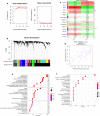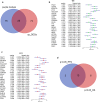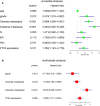Pentraxin 3 is a diagnostic and prognostic marker for ovarian epithelial cancer patients based on comprehensive bioinformatics and experiments
- PMID: 33952272
- PMCID: PMC8097951
- DOI: 10.1186/s12935-021-01854-7
Pentraxin 3 is a diagnostic and prognostic marker for ovarian epithelial cancer patients based on comprehensive bioinformatics and experiments
Abstract
Background: Ovarian epithelial cancer is one of the leading malignant tumors in gynecology and lacks effective diagnostic and prognostic markers. Our study aims to screen and verify ovarian epithelial cancer biomarkers.
Methods: GSE18520 and GSE26712 were downloaded from the GEO database. The "limma" and "WGCNA" packages were used to explore hub genes. The Kaplan-Meier Plotter database was used for survival analysis of the hub genes. Immunohistochemical analysis was used to identify the expression level of Pentraxin 3 in ovarian epithelial cancer samples.
Results: In this study, we integrated and analyzed two datasets, GSE18520 and GSE26712, and a total of 238 differentially expressed genes (DEGs) were screened out. Enrichment analysis showed that these DEGs were related to collagen-containing extracellular matrix and other pathways. Further application of WGCNA (weighted gene coexpression network analysis) identified 15 gene modules, with the purple module showing the highest correlation with ovarian epithelial cancer. Twenty-five genes were shared between the purple module and DEGs, 13 genes were related to the prognosis of ovarian epithelial cancer patients, and the PTX3 gene had the highest hazardous risk (HR) value. We performed immunohistochemical analyses on the 255 Pentraxin-3 (PTX3)-based clinical samples. PTX3 was found to be overexpressed in ovarian epithelial cancer and related to the degree of differentiation. The Cox proportional hazard model indicates that high PTX3 expression is an independent risk factor for the prognosis of ovarian epithelial cancer patients.
Conclusions: In conclusion, through WGCNA and a series of comprehensive bioinformatics analyses, PTX3 was first identified as a novel diagnostic and prognostic biomarker for ovarian epithelial cancer.
Keywords: Biomarker; Ovarian epithelial cancer; PTX3; Prognosis; WGCNA.
Conflict of interest statement
All authors declare that no competing interests exist.
Figures







References
-
- Lheureux S, Braunstein M, Oza AM. Epithelial ovarian cancer: Evolution of management in the era of precision medicine. Cancer J Clin. 2019;69:280–304. - PubMed
LinkOut - more resources
Full Text Sources
Miscellaneous

